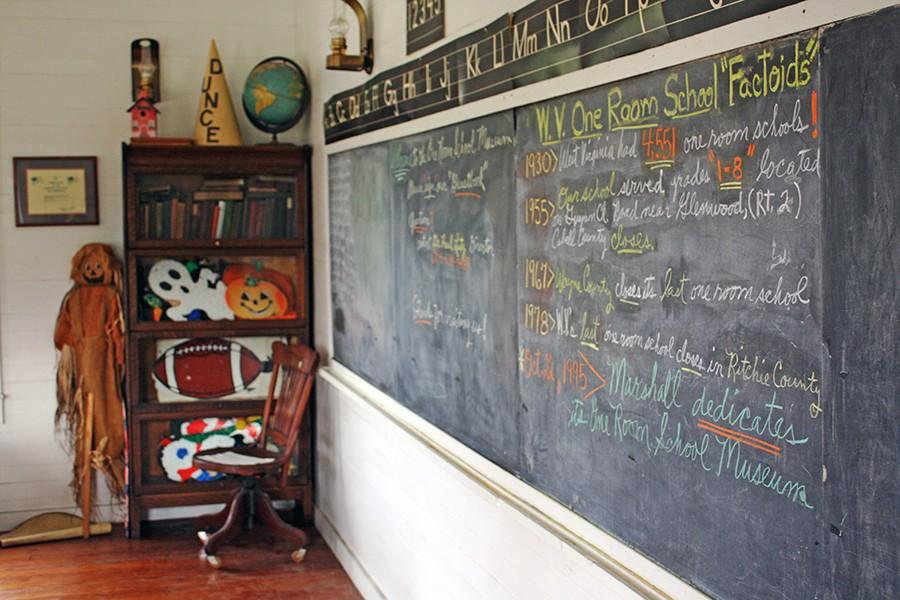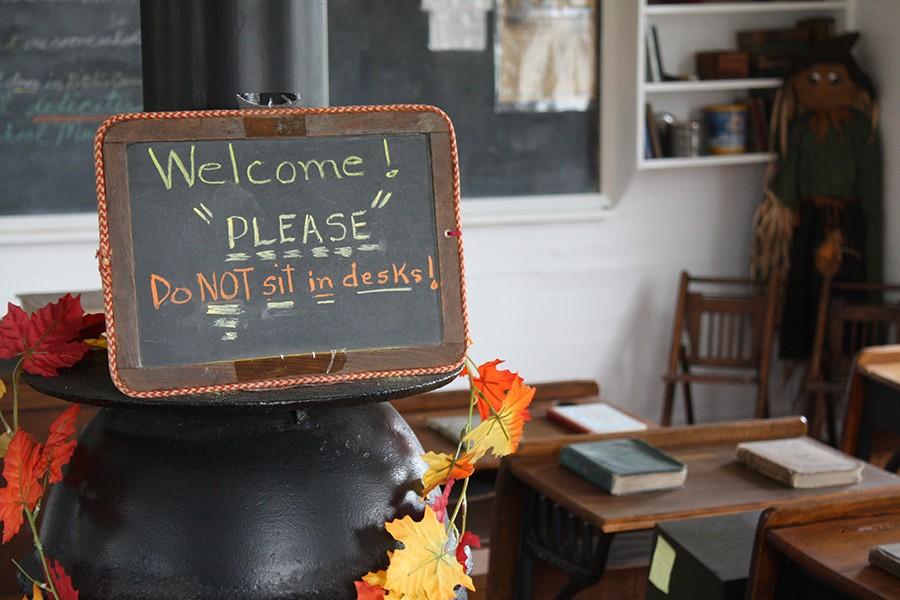The forgotten classroom
More stories from Rebecca Turnbull
One room school house facts are displayed on a chalkboard in the Marshall University One-Room Schoolhouse Museum.
For the first time in nearly five decades, a piece of chalk was once again drawn against the black slate chalkboard of Union School. This time, instead of the alphabet and equations, the chalk was used to write, “Welcome to the One-Room School Museum.”
West Virginia history professor Paul Lutz had just put the finishing touches on the former Union School building for its grand reopening as the Marshall University One-Room School Museum October 21, 1995.
It had taken Lutz five years to find the century-old Union School, but only a matter of months to physically move the school 24 miles from its original location on Guyan Creek Road in Cabell County to the former Fifth Avenue green space of Marshall’s campus where it still stands today.
What had started out as a student’s idea to interview a one-room schoolteacher for a final research paper had become an important historical contribution to Marshall’s campus, with the help of Lutz, former Marshall president Wade Gilley and local donor Bill Cline.
Lutz recalls the pride he felt for Marshall at the moment the school finally arrived across from the college of education.
“It was my project,” Lutz said. “It was my baby.”
Union School, formerly referred to as “Punkin Center School” by the locals, had housed students grades one through eight from 1889 to the 1950s. When Lutz found the school, it was being used for storage by its owners Tina and James “Bill” Bryan. The Bryans readily donated the school to serve a greater purpose for the Marshall community.
Storage was moved out and a school was moved back in. Desks and books that had been used in one-room schoolhouses were donated by many people in the community.
Lutz said the museum offers a poignant mosaic of valuable history and community collaboration.
“I don’t think people realize what a unique museum it is,” Lutz said. “I mean, the school is an actual school building. It is not a replica. It is like stepping back into time to walk into the school. It’s the real thing. It’s really an expression of the whole community and just the respect for the historical aspect of education in general.”
One group on campus continues to keep these efforts toward the preservation of history appreciated and seen by the Marshall community.
The John Marshall Emerging Leaders Institute will reopen the One-Room School Museum for the spring March 28. JMELI members will be available in the schoolhouse almost every weekday from 12 p.m. to 2 p.m.
When Lutz retired from Marshall in 2006, he said he began a search for help from an organization to take over and care for the schoolhouse.
Lutz caught wind of Marshall’s then new JMELI group in 2014 and asked coordinator Andy Hermansdorfer if they would be willing to oversee the conservation of the project. To Lutz’s joy, Hermansdorfer accepted the opportunity.
“That’s really been a lifesaver to have the school open by these students and I really appreciate everything they’ve done,” Lutz said.
JMELI graduate advisor Kelsea Ring currently recruits greeters for the schoolhouse. Ring said the organization continues to provide volunteers to the schoolhouse to give members the opportunity to reach out and connect with Marshall’s campus.
“It’s a good leadership opportunity for them, getting in contact with the community, getting in contact with Marshall’s campus,” Ring said. “It gives them a place to go and helps them to get to know part of West Virginia’s history.”
Freshman biology pre-med student and JMELI member Jack Victory serves as a greeter for the schoolhouse and said he looks forward to volunteering in the schoolhouse this spring.
“A lot of people would think maybe that the opportunity is just boring to sit in there, but you get to meet some really cool people and observe the historical side of that and see how the county was represented a few decades ago,” Victory said. “It’s a great opportunity for the public to kind of see like how school was in the past, to see the difference between school back then and how it is now, because it’s such a big change. It’s a living piece of history.”
Freshman athletic training major and JMELI member Rachel Gwilliams also serves as a greeter for the schoolhouse and said she was initially surprised by the inviting atmosphere of the schoolhouse.
“I didn’t know what it was,” Gwilliams said. “It was a little white building and I wasn’t sure what was going to be in there, but when you open the doors it’s almost breathtaking. You don’t expect it to be set up like that and look exactly how it did when they were in school. It’s kind of like a comfort zone.”
Gwilliams said the schoolhouse seems to serve as a memorial to Marshall’s humble beginnings as a one-room school in a little Methodist Church that formerly stood on the site of Old Main, a part of history she learned while volunteering.
“It shows us where we’ve come from, how Marshall started out as one school and how it’s grown into this entire university, with students all over the world coming to it,” Gwilliams said. “If we don’t realize what we’ve come from, then we’re not going see what we’re going to be able to get into in the future. We need people that’ll care about it and keep it going for everyone to see it in the future.”
Lutz said the schoolhouse, while not originally a part of the university, serves as a testament to Marshall’s pre-Civil War history and the history of education in West Virginia overall.
“It’s a reminder of the importance of teachers and community and the heritage of a bygone day when grades one through eight were included in that one school,” Lutz said. “Every hill and holler had a one-room school.”
Lutz said the schoolhouse is in need of more attention from the campus community for it to serve its purpose.
“It’s a shame we don’t get enough publicity about how unique it is,” Lutz said. “Anything and everything to make it more visible to not just the campus but the community is beneficial.”
Students interested in serving as a greeter at the schoolhouse may contact Ring or Hermansdorfer on weekdays in the office of Student Affairs room 2W38 on the second floor of the Memorial Student Center.
Rebecca Turnbull can be contacted at [email protected].
Your donation will help continue the work of independent student journalism at Marshall University. If you benefit from The Parthenon's free content, please consider making a donation.




William woodard • Sep 20, 2020 at 6:38 pm
My mother taught at this school for many years. I have a lot to add to the history of this school. Contact me if you are interested. I graduated from Marshall in 1957.
"Sonny" James M. Bryan, Jr. • Jun 29, 2016 at 6:50 pm
I’m over sea working in Ruwais,UAE. Born and raised in West Virginia and now live in Ft. Worth, Texas. Beind home sick and knowing all the bad weather y’all had in West Virginia, I looked up on line the one room school house my dad and mom owned on Guyan Creek, our family worked some long hours in the old school house working toabacco crops. I found that my dad’s name was wrong you had James E. Bryan this needs to be corrected his name was “James M. Bryan”.
Its always good to look at the old Pumkin Center One Room School House.
Go Herd!
Sonny Bryan